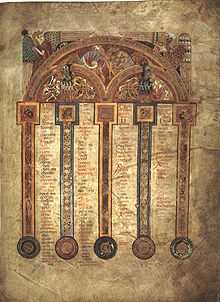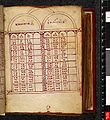Eusebian Canons

Eusebian canons, Eusebian sections or Eusebian apparatus,
The canon tables were made to create a sense of divinity within the reader’s soul, to understand and reflect upon the various colors and patterns to achieve a higher connection with God.[6]
Authorship
Until the 19th century it was mostly believed that these divisions were devised by
The Eusebian Tables


The harmony of Ammonius suggested to Eusebius, as he says in his letter, the idea of drawing up ten tables (kanones) in which the sections in question were so classified as to show at a glance where each Gospel agreed with or differed from the others. In the first nine tables he placed in parallel columns the numbers of the sections common to the four, or three, or two, evangelists; namely: (1) Matt., Mark, Luke, John; (2) Matt., Mark, Luke; (3) Matt., Luke, John; (4) Matt., Mark, John; (5) Matt., Luke; (6) Matt., Mark; (7) Matt., John; (8) Luke, Mark; (9) Luke, John. In the tenth he noted successively the sections special to each evangelist. Sections "Mark, Luke, John" and "Mark, John" are absent because no text is common to Mark and John without a parallel in at least Matthew.
| Table # | Matthew | Mark | Luke | John |
|---|---|---|---|---|
| In Quo Quattor | ||||
| Canon I. | Yes | Yes | Yes | Yes |
| In Quo Tres | ||||
| Canon II. | Yes | Yes | Yes | |
| Canon III. | Yes | Yes | Yes | |
| Canon IV. | Yes | Yes | Yes | |
| In Quo Duo | ||||
| Canon V. | Yes | Yes | ||
| Canon VI. | Yes | Yes | ||
| Canon VII. | Yes | Yes | ||
| Canon VIII. | Yes | Yes | ||
| Canon IX. | Yes | Yes | ||
| In Quo Matth. Proprie | ||||
| Canon X | Yes | |||
| In Quo Marc. Proprie | ||||
| Canon X | Yes | |||
| In Quo Luc. Proprie | ||||
| Canon X | Yes | |||
| In Quo Ioh. Proprie | ||||
| Canon X | Yes | |||
The usefulness of these tables for the purpose of reference and comparison soon brought them into common use, and from the 5th century the Ammonian sections, with references to the Eusebian tables, were indicated in the margin of the manuscripts. Opposite each section was written its number, and underneath this the number of the Eusebian table to be consulted in order to find the parallel texts or text; a reference to the tenth table would show that this section was proper to that evangelist. These marginal notes are reproduced in several editions of Tischendorf's New Testament.
Eusebius's explanatory letter to Carpianus was also very often reproduced before the tables.
Illuminated canon tables
The tables themselves were usually placed at the start of a
Images
-
Eusebian tables before text of the Gospels in Codex Harleianus 5567 (Gregory-Aland 116; 12th century)
-
One of the canon tables from the 8th century Codex Beneventanus.
-
The London Canon Tables are two folios from a Byzantine manuscript of the 6th or 7th century, showing the typical arcaded frame.
See also
Notes
- ^ D. C. Parker, An Introduction to the New Testament Manuscripts and their Texts, Cambridge University Press, 2008, p. 24.
- ^ Sebastian P. Brock, 'Review of Alain Desreumaux, Codex sinaiticus Zosimi rescriptus (Histoire du Texte Biblique, 3), The Journal of Theological Studies, NEW SERIES, 50 (1999), p. 766.
- ^ Christa Müller-Kessler and Michael Sokoloff, The Christian Palestinian Aramaic New Testament Version from the Early Period. Gospels (A Corpus of Christian Palestinian Aramaic, IIA; STYX: Groningen, 1998), pp. 94–95, 97, 139–140, 168–169.
- ISBN 0-300-05819-5
- ISBN 978-0-19-502924-6
- ISBN 0-89236-640-0.
- ^ Martin Wallraff, Die Kanontafeln des Euseb von Kaisareia (Manuscripta Biblica
Paratextus Biblici, 1) Berlin/Boston: Walter de Gruyter, 2021. ISBN 978-3-11-043952-6
References
 This article incorporates text from a publication now in the public domain: Herbermann, Charles, ed. (1913). "Ammonian Sections". Catholic Encyclopedia. New York: Robert Appleton Company.
This article incorporates text from a publication now in the public domain: Herbermann, Charles, ed. (1913). "Ammonian Sections". Catholic Encyclopedia. New York: Robert Appleton Company.



